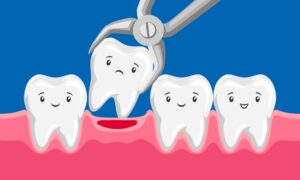
If you have a child at home who resists brushing and flossing, you’re not alone. A 2019 study conducted by Oral-B found that 70% of parents say that ensuring their kids regularly clean their teeth is the most stressful part of their job as parents. Unfortunately, if your little one develops cavities that go unnoticed, their pearly whites can erode past the point of being repaired or preserved. As a result, your pediatric dentist may have to extract them to keep decay or infection from spreading.
To help your child recover as quickly and efficiently as possible, it’s important to follow any post-op instructions in detail. Continue reading to learn 3 tips that can help them heal without developing complications!
Tip #1: Be Aware of Numbness
Depending on their unique circumstances, your child will be numbed and/or sedated for their tooth extraction. This ensures that they don’t experience any discomfort during the procedure, but it can pose some challenges after their appointment. It’s easy for young people to accidentally bite their tongue or the inside of their cheeks and lips while they’re still numb, which can be incredibly painful after the fact.
To prevent this, it’s recommended that you provide them with only soft or liquid foods that they don’t have to chew until the medications have worn off completely. Options like warm (but not overly hot) soups, smoothies, pudding, and yogurt can satisfy empty tummies without risking injury.
Tip #2: Encourage Them to Rest
Once your child’s tooth is removed, their mouth will start to form a blood clot over the now-empty socket to protect the sensitive nerves that would otherwise be left exposed. They’ll need to take it easy for at least 24 hours following their extraction to ensure that it isn’t dislodged. Any physical activities that elevate their heart rate or increase blood pressure can damage the clot and should be averted.
Many children find it difficult to be still or avoid active play, but you can help by setting them up somewhere comfortable where they can rest. You can make it fun by offering other activities to keep their minds preoccupied. For example, you might enjoy a movie marathon with them on the living room sofa or let them read their favorite books or comics for the rest of the day.
Tip #3: Relieve Their Pain
It’s normal for your little one to have mild to moderate aches and inflammation for a few days after their tooth extraction. To give them some much-needed relief, you can apply a cold compress to that side of their face for about 20 minutes at a time. This can reduce swelling and create a temporary numbing sensation to alleviate their aches.
It’s usually also safe to give them over-the-counter medications like Children’s Tylenol or ibuprofen, but it’s a good idea to check with their provider first to ensure there won’t be any unforeseen consequences.
If your child experiences persistent pain or bleeding that lasts for a week or more after their extraction, contact your pediatric dentist right away so they can ensure that everything recovers as intended.
About the Author
Dr. Lily at Shiny Smiles Pediatric Dentistry offers a full range of services under one roof to help children build and maintain strong, healthy teeth and gums. She pursued her doctorate from the Western University of Health Sciences in Pomona, CA, and then completed her Advanced Education in General Dentistry certification at the Lutheran Medical Center in Brooklyn. After that, she completed her pediatric certification at the University of Nevada in Las Vegas. Now, she’s a member of several professional organizations, including the American Academy of Pediatric Dentistry, so you know your child’s grin is in good hands. If your kid has a toothache or cavity that might require extraction, you can request an appointment on the website or by calling (469) 925-0861.

